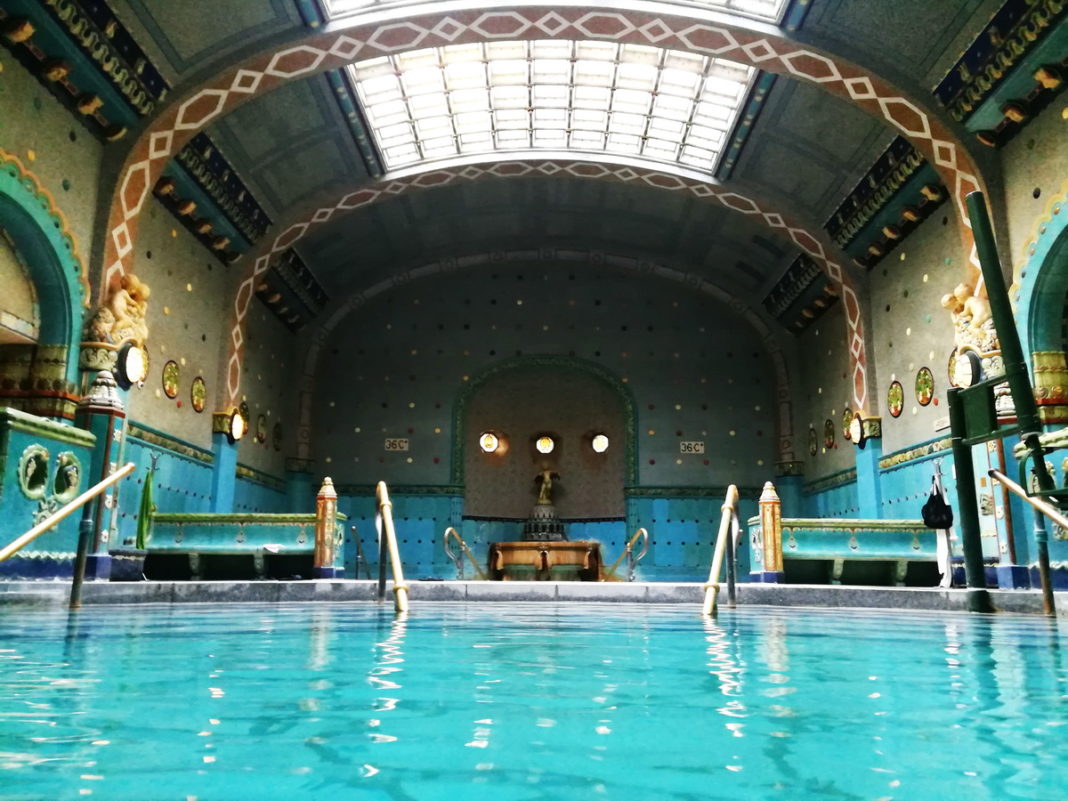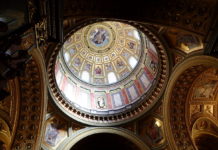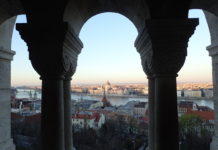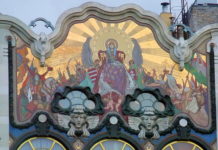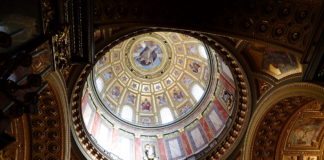2 or 3 days in Budapest is just enough time to get a varied experience of the city. Our Budapest itinerary covers a generous taste of everything the city is famous for – the Budapest baths and hot springs, the ruin pubs, the opulent Hungarian Secession architecture, the even more sumptuous Hungarian desserts, and the monuments like the Hungarian Parliament Building, the Fisherman’s Bastion, the bridges (the Chain Bridge, the Liberty Bridge) and Buda Castle. Add to these the essential experience of lounging in the opulent Budapest cafés – this is the city that invented café culture – plus a little antique shopping, and taking in a performance at the Hungarian Opera House, and you have the makings of a perfect Budapest city break or weekend trip.
There’s a lot to see in Budapest in two days. But this 2 or 3 day Budapest itinerary includes plenty of leisure. This old-world capital offers the perfect mix of culture and hedonistic relaxation in its famous cafes and spas.
Table of Contents
Getting to Know Budapest in 2 (or 3) Days – Buda and Pest
As you likely know, Budapest is divided by the Danube River into Buda and Pest. Many bridges traverse the Danube in this very walkable city, and so do the trams. The two sides have their distinctive topographies, characters and attractions.
Once separate cities, Buda, Pest, and Óbuda (Old Buda”) came together as Budapest in 1873. This was just six years after the Austro-Hungarian compromise (1867), which brought both autonomy and wealth. This brought about a definitive period for Budapest – there was a great period of building to create a grand European capital. The population surged, drawing artists, writers, and intellectuals. Where did they all converge? At the cafes to debate, and at the baths to relax – still heart of the Budapest experience.
What Makes a Budapest an Effortless City Break Destination
Budapest serves up all the glamour of fin de siècle Mitteleuropa at its shamelessly sumptuous best. The sense of place is profound.
This, combined with the ruin pubs and the stellar examples of contemporary architecture, makes Budapest a vibrant city break destination with some pedigree and depth. Budapest is rich in atmosphere throughout – whether you’re at one of the landmark destinations, or on your way there – providing a constant experience
2 or 3 Days in Budapest, Day 1: Pest – Applied Arts Museum, Central Market Hall, Vaci Utca, Centrál Café, Dohány Street Synagogue, Cafe Gerbaud, Budapest Eye, St. Stephen’s, Szechenyi Baths, Andrassy Avenue, Hungarian State Opera House, New York Café, Ruin Pubs
It sounds like a lot, but day one of our Budapest two day itinerary is really just some strolling and taking it all in, a couple of sights, and a little café hopping and a steam bath and soak in the neo-Baroque hot springs to recharge in style.
2 or 3 Days in Budapest, Morning of Day 1
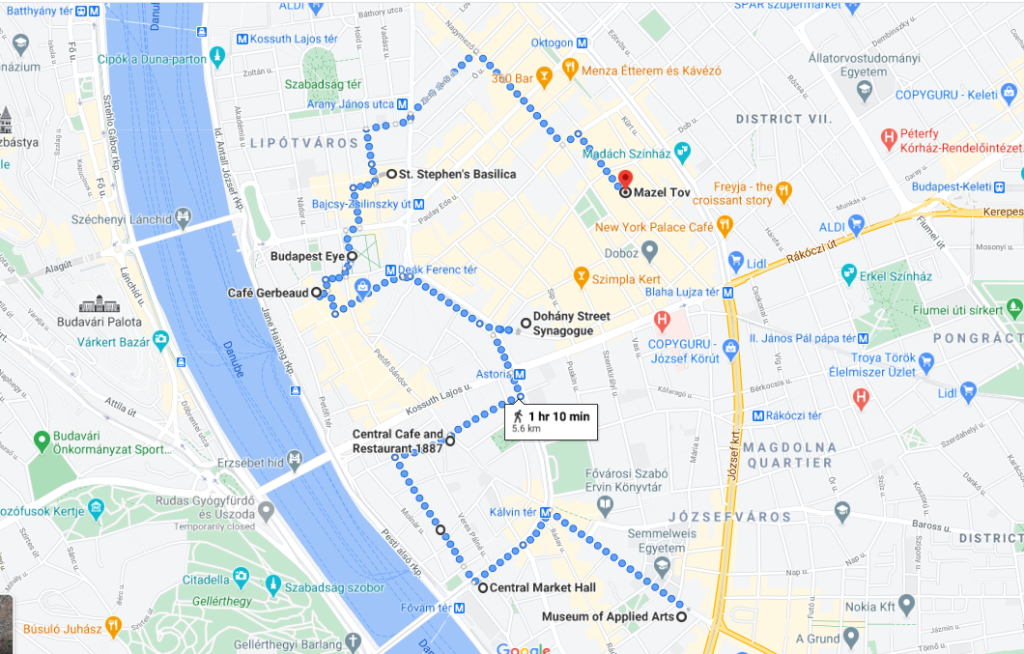
Starting at the Applied Arts Museum and ending with lunch, we’ll take in the Central Market Hall, the shopping street Váci utca, the Dohány Street Synagogue, the Budapest Eye, and St. Stephens in between. The walk is just over an hour – a little less than 6 km.
The Applied Arts Museum of Budapest
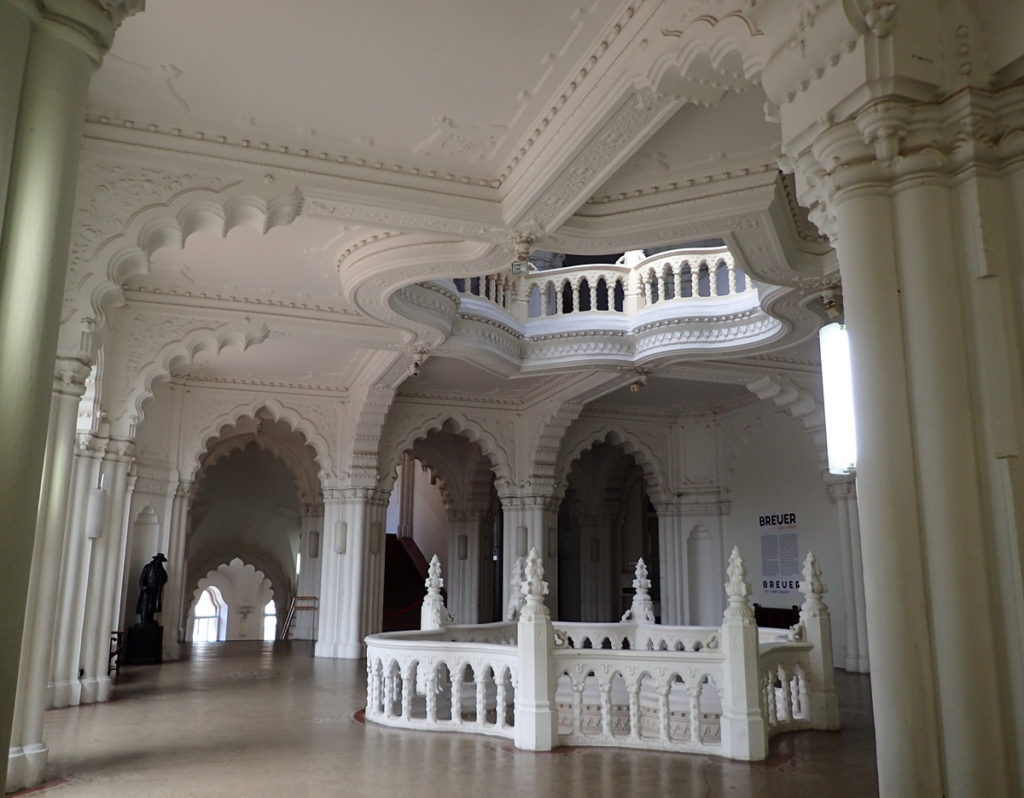
The Museum of Applied Arts – Interior 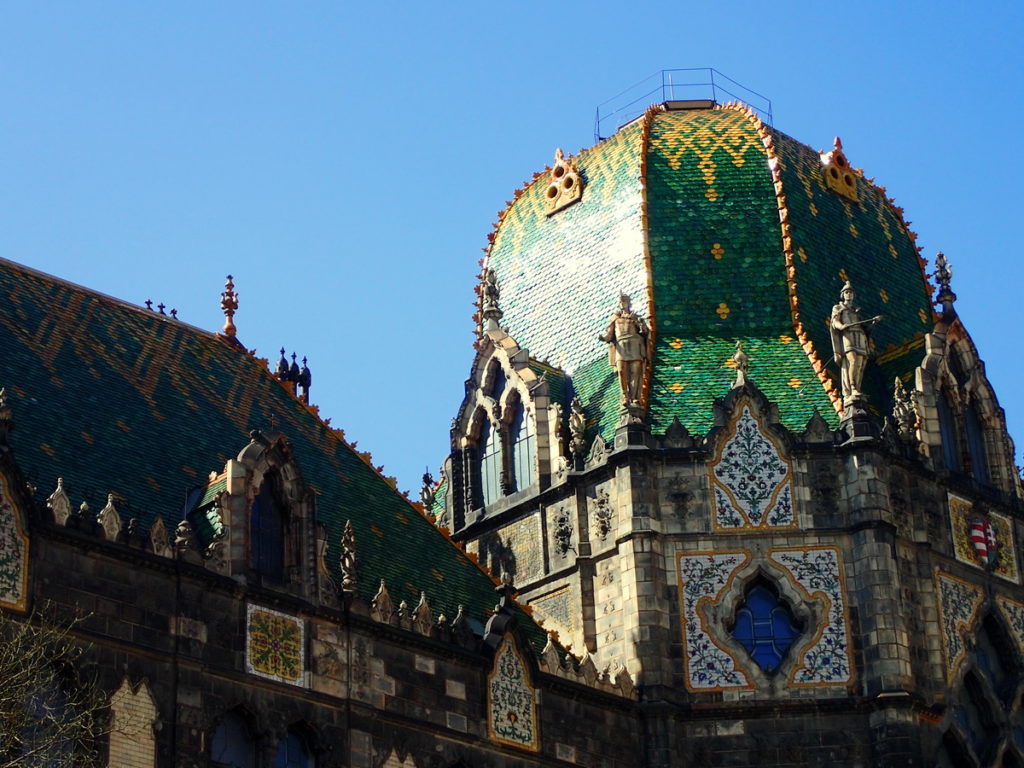
The Tiled Roof of the Museum of Applied Arts
This is the third oldest museum of applied arts in the world, and the collection of decorative arts – furnishings, glassware, textiles, metalwork – is gorgeous. But the real star of the Museum of Applied Arts of Budapest (Iparművészeti Múzeum) is the building, one of the best examples of Hungarian Secession style, by Ödön Lechner. He was the premier architect for this distinctively Hungarian interpretation of the Art Nouveau (France, Belgium), Modernismo (Spain), Stile Liberty (Italy), Jugendstil (Germany), and Secession (Hungary, Austria) movements sweeping fin de siècle Europe. The Hungarian movement is bolder and wilder than most of its other European counterparts, incorporating Hungarian folk motifs and eastern influences. There is also a heavy reliance on tile – a distinctively Hungarian material, made from the earth of the great Hungarian plains and finding its peak of expression through the pioneering work of the Zsolnay company. Ödön Lechner is sometimes referred to as the Hungarian Gaudí, in part because of his creative use of tile. But the true connection between the architects is the question of identity – Lechner’s works are an expression of a distinctive Hungarian identity (as opposed to Austro-Hungarian), as Gaudí’s works are distinctively Catalan (as opposed to Spanish).
The Central Market Hall – Great Market Hall of Budapest
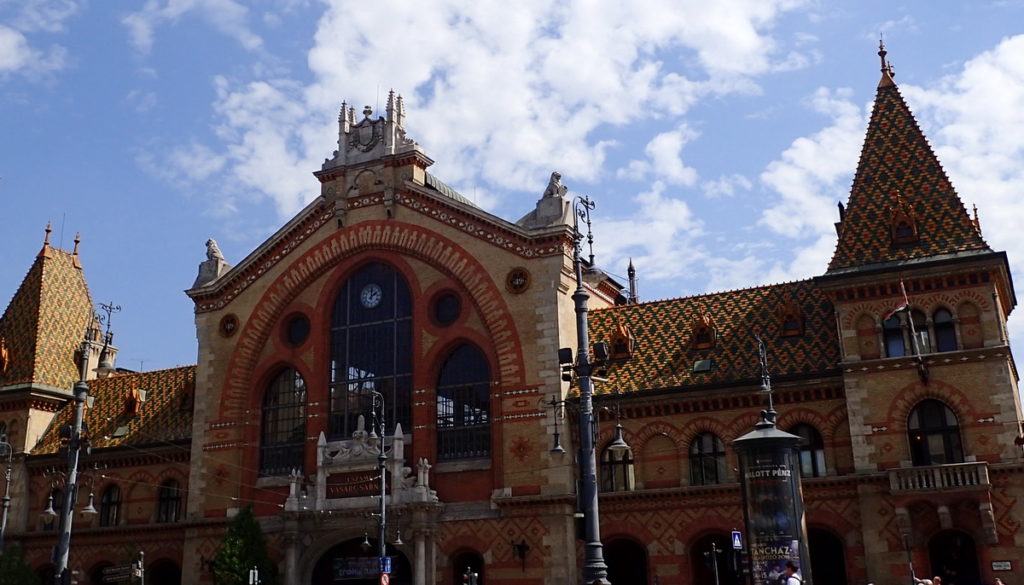
It’s very touristy. But it’s also lovely, and – by the Liberty Bridge and the beginning of Vaci Utca – therefore directly on our route. The 1897 Great Market Hall of Budapest (Nagyvásárcsarnok) was designed in a neo-Gothic style by Samu Pezc. The building has a facade of ornate brickwork and a fantastically colorful roof of Zsolnay tile. Inside, the glass and iron construction is airy and lovely. Although you could get traditional Hungarian food items on the ground floor and souvenirs and crafts on the upper floor, we’re only stopping off for the architecture and the general buzz – the market unfortunately has a bad reputation for scamming tourists.
2 or 3 Days in Budapest – The Váci utca
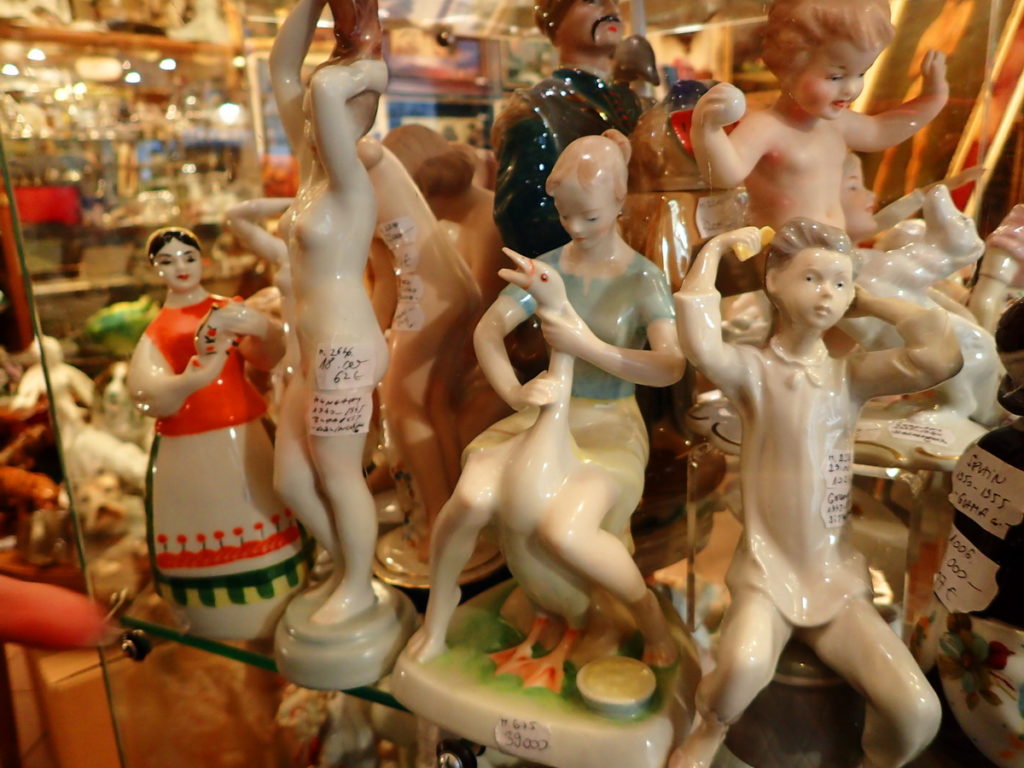
This famous pedestrian street is lined with cafés and mostly tourist shops. But you may still spot some antique stores. If you do, stop in for a look at the porcelain figurines from the famous workshops of Zsolnay (of the tiles) and Herrend. These are more collectibles than souvenirs, and prices are high. In the right mood they look like Jeff Koons works in miniature.
Centrál Café – Centrál kávéház
Finally time for a coffee, and the Central Café (Centrál Kávéház) is worth waiting for. The kávéház (coffee house) is a cultural institution in Budapest; the Centrál Café, of 1887, was one of the definitive cafés of the golden age of café culture. The intelligentsia of the day – composers, scientists, poets, artists – congregated here to socialize, philosophize, and work. In fact, literary journals were edited the café’s marble tables. The café has been beautifully restored, and you can see photos of some of its most illustrious patrons pf the past on its walls. Try a mélange – the Hungarian caffè latte, which we hear the Hungarians sweeten with honey, rather than sugar.
Dohány Street Synagogue
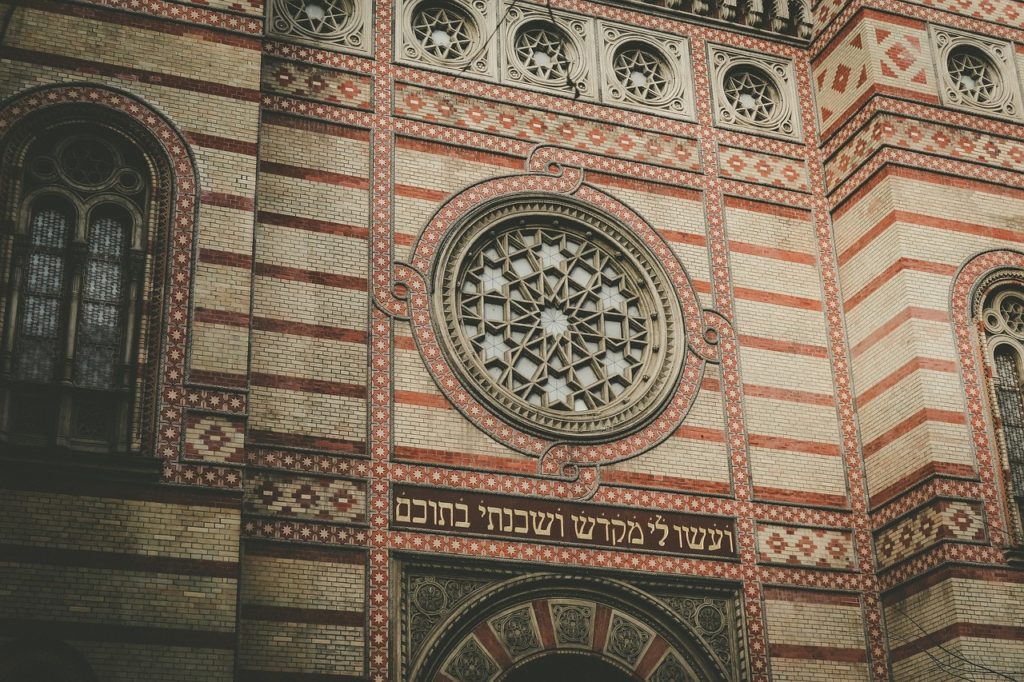
Also known as the Great Synagogue or Tabakgasse Synagogue, the Dohány Street Synagogue (Dohány utcai zsinagóga) is in the VIIth district – the Erzsébetváros (“Elizabeth Town” – named for Hungarian Queen/Austrian Empress popularly known as “Sisi”). This is the old Jewish quarter and one Budapest’s most densely populated and interesting neighborhoods (and now one of its most famous, in part because of the Ruin Pubs). The Dohány Street Synagogue of 1859 is Europe’s largest working Synagogue. The Austrian architect Ludwig Förster – known best for his Synagogues designed it in a Moorish revival style, taking his inspiration from North Africa and Muslim Spain – areas where Jews had historically lived.
The VII District still has a strong Jewish presence overall. Dohány Street marked the border of the Jewish ghetto during WWII, and therefore carries the memories of the holocaust. In the Dohány Street Synagogue complex, in addition to the synagogue itself, you’ll find the Heroes’ Temple, a memorial, a cemetery, and the Jewish Museum – the museum is built on the site of the home where Theodore Herzl – the father of political Zionism – once stood.
Ludwig Förster is related to two influential late 19th century architects – Otto Wagner, a leading architect of the Viennese Secession movement, worked together with Förster in his studio. Förster also worked with the famous Neoclassicist Theophil Hansen, who helped define Athens with masterpieces like the Academy of Athens and the National Library of Greece of the famous “Athenian Trilogy. Hansen was also Förster’s son-in-law.
Café Gerbeaud – Gerbeaud Cukrászda
A cukrászda is a pâtisserie, and Gerbeaud is the most pastry-forward of the famous cafés of Budapest. Gerbeaud is on Vörösmarty Square (Vörösmarty tér) – the main central square of Budapest, in the V district. It’s beautiful, but a little chaotic, touristy, and perhaps over-priced. Have look at the display cases though and take a slice of their famous Gerbeaud slice (a yeasted cake layered with apricot jam and topped with chocolate) or another Hungarian classic torte from their selection. Take-out will probably be less expensive.
2 Days in Budapest – Budapest Eye
This 65 meter high Ferris Wheel in Erzsébet Square is a fun (if pricy – 3000 HUF / about €10) way to get an overview of the city. The ride takes 8 to 10 minutes. If you want a viewpoint without a taking a ride, wait until our next stop.
St. Stephen’s Basilica – Szent István-bazilika
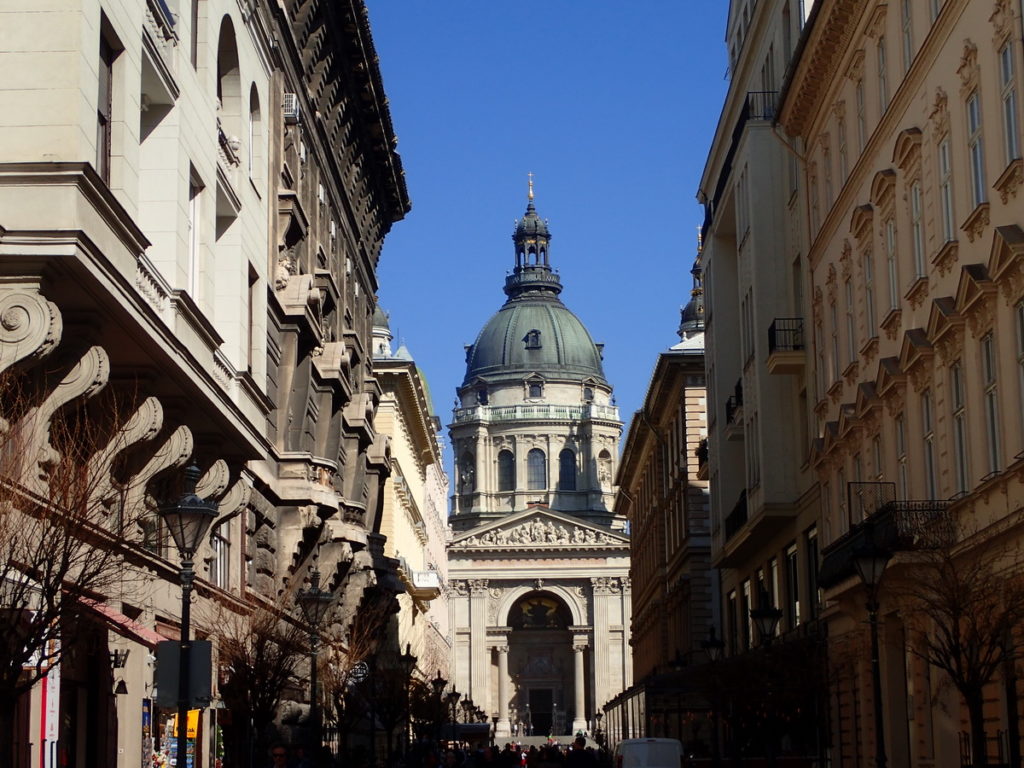
This neoclassical cathedral of 1905 is full of splendid mosaics, bronze reliefs, glass painting, and sculpture from the finest artists and artisans of the day. It was designed by Miklós Ybl – also the architect of the Hungarian State Opera House, and took over 50 years to complete. At 96 meters in height, St. Stephen’s Basilica is one of Budapest’s two tallest buildings – the other is the Parliament building, their equal height symbolizing the balance of power between church and state.
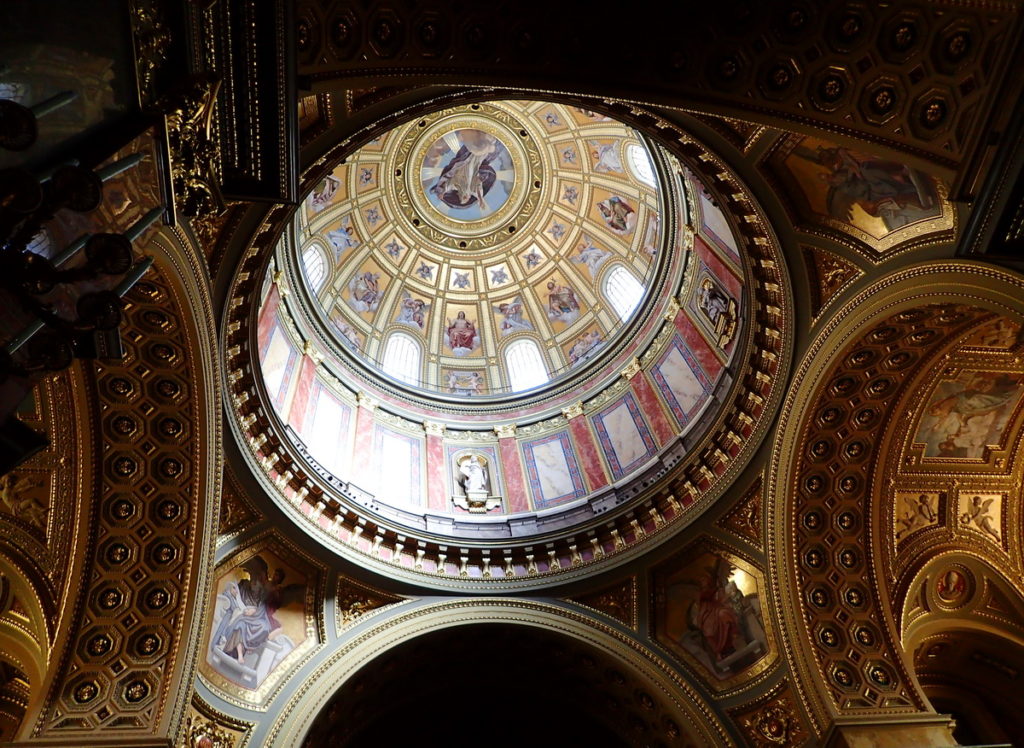
The gilded dome of the Neoclassical St. Stephen’s Basilica 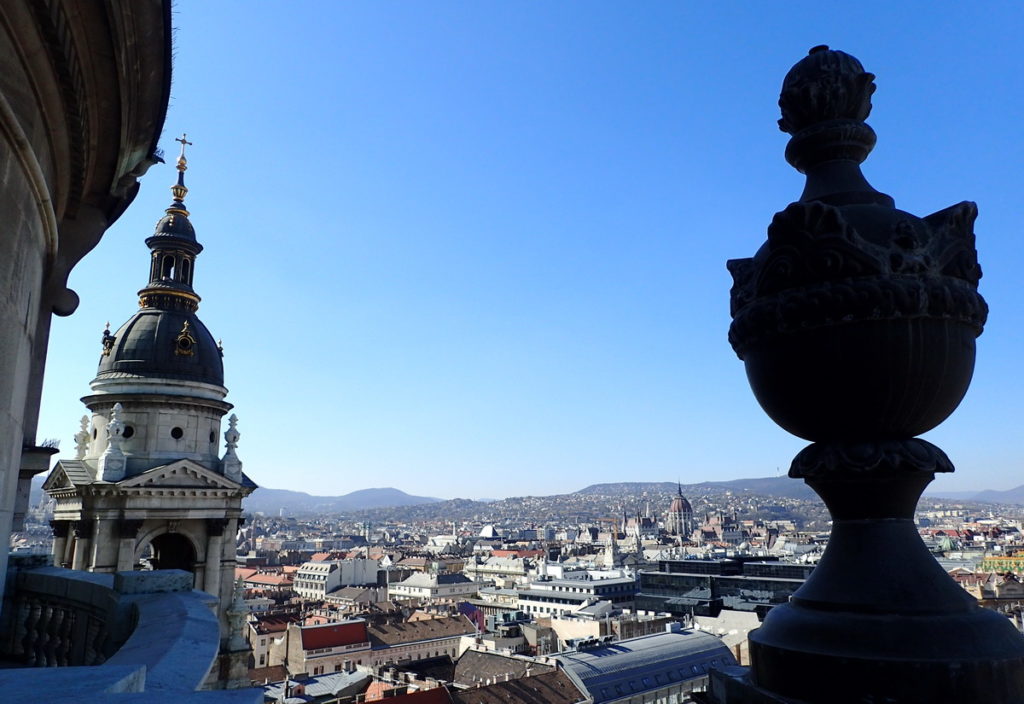
The View from St. Stephen’s
Speaking of height, for a small fee you can ascend a very narrow and winding set of stairs (over 350 steps) to the roof. It’s a spectacular panoramic view of the whole of Budapest. Look down for an excellent view of the Postal Savings Bank – one of Ödön Lechner’s most famous buildings (look for the ceramic beehives). Visiting St. Stephen’s and getting oriented on the roof is a great thing to do on a 2 or 3 days in Budapest city break.
Concerts are frequently held in the basilica – there’s more information here.
Lunch Break at Mazel Tov
We can circle back to the VII district for lunch at Mazel Tov – one of the most talked-about and most photographed casual restaurants in Budapest in the ruin pub district. Enjoy eastern Mediterranean dishes under a high glass ceiling, plants all around.
There are many other restaurants that are closer to St. Stephen’s and the Oktagon – our point of departure for the afternoon. Reviews are mixed.
Alternatively, if you’re feeling flush, you can lunch at the legendary Gundel, in the city park (Városliget) – our first stop for the afternoon. Details in the next section.
2 Days in Budapest – Afternoon of Day 1: Metro Line 1, Hősök tere (Hero’s Square), Városliget (City Park), Széchenyi Baths, Andrassy Avenue, Hungarian State Opera House, Bar Hopping in the VII
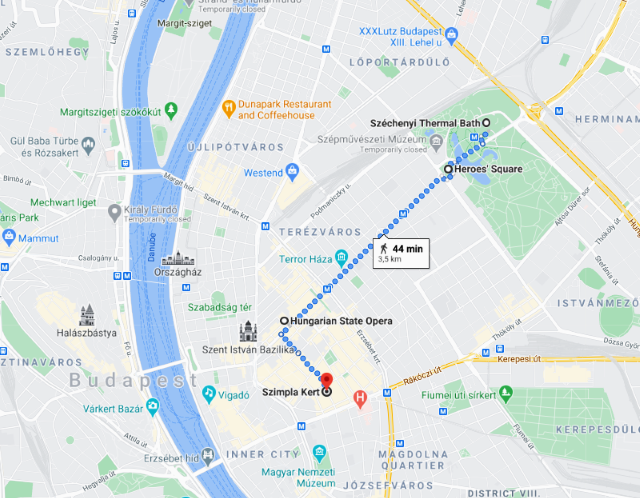
The Octagon is a major intersection of Pest where the Grand Boulevard (Nagykörút) and Andrassy Avenue (Andrássy út) meet. Andrassy Avenue is a destination in itself, but for now, we’ll take the Metro from here to the Városliget – the famous City Park of Budapest. The Városliget is full of attractions, including the Széchenyi Baths (Széchenyi gyógyfürdő). After a wallowing in the famous hot springs of Budapest – possibly followed by late lunch at Gundel – we can stroll back along glamorous Andrassy Avenue, taking in the Hungarian State Opera House. Keeping in the posh mood, we’ll continue on to New York Cafe – but maybe just for a peek. By evening, the ruin pubs and wine bars in the VII district are a better choice.
The Budapest Metro, Line 1 – Oktagon to Széchenyi gyógyfürdő (the Széchenyi Baths) or Hősök tere (Heroes’ Square)
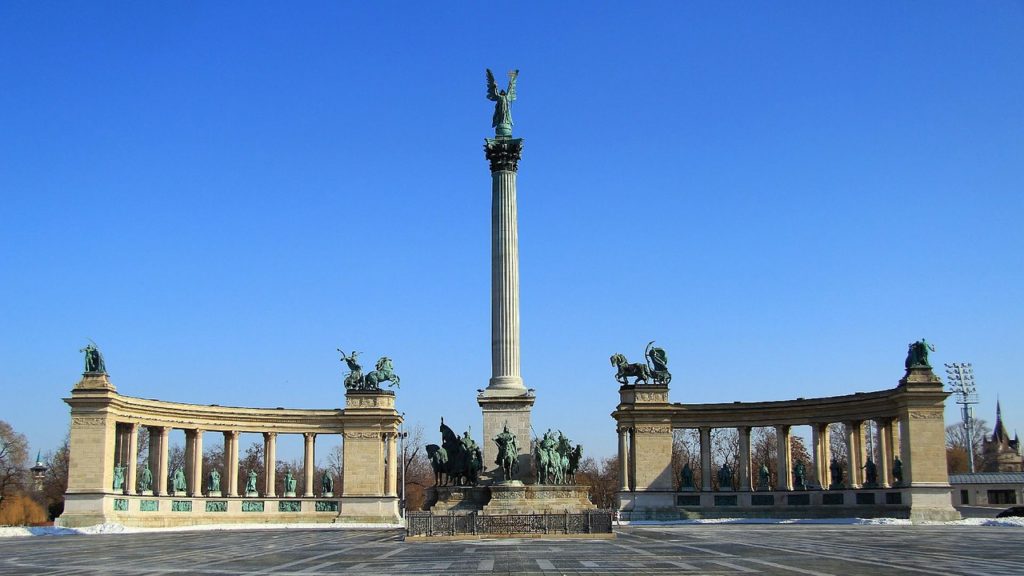
It’s nice when the transport itself is part of the experience. Budapest’s M1 – Millennium Underground Railway, Metro 1 – is the oldest metro in continental Europe, built from 1894 -1896 and inaugurated by Franz-Joseph. It’s called the Millennium railway to commemorate the anniversary of the arrival of the Magyars, 1000 years before. The beautiful stations of tile and wrought iron are just one story below street level. If we want to get straight to the Széchenyi Baths, we can get off at the last stop.
Otherwise we can get off at Hősök tere (Heroes’ Square) the official entrance to the Városliget – Budapest’s glamorous city park. Hero’s Square is monumental sculpture complex featuring the equestrian statues of the seven chieftains of the Magyars – the leaders of the seven tribes of Hungarians who arrived in the Carpathian basin in 895 to found Hungary. The column in the center is topped by the Archangel Gabriel, holding the Hungarian Holy Crown of St. Stephen. St. Stephen was the first King of Hungary, the first in his family to become a devout Christian, and spread Christianity throughout the land.
The Budapest City Park – Városliget
This very impressive city park packs a lot into its 1.2 square kilometers. We’re chiefly here for the Széchenyi Baths. But if you prefer to stay dry, you can visit the Municipal Botanical and Zoological Gardens (amazing Secession-style entrance), the Museum of Fine Arts, Budapest, or the contemporary exhibitions at the Budapest Hall of Art (Palace of Art). You’ll also not want to miss the Vajdahunyad Castle (Vajdahunyad vára). In fact, you can’t miss it – built originally for the Millennial celebrations in 1896, it unites the designs of several famous buildings from throughout the Kingdom of Hungary in a Disney-esque architectural interplay between Romanesque, Gothic, Renaissance, and Baroque styles. There’s a boating pond in front of the castle, which transforms into Europe’s largest public ice skating rink during the winters.
Széchenyi Baths – Széchenyi gyógyfürdő
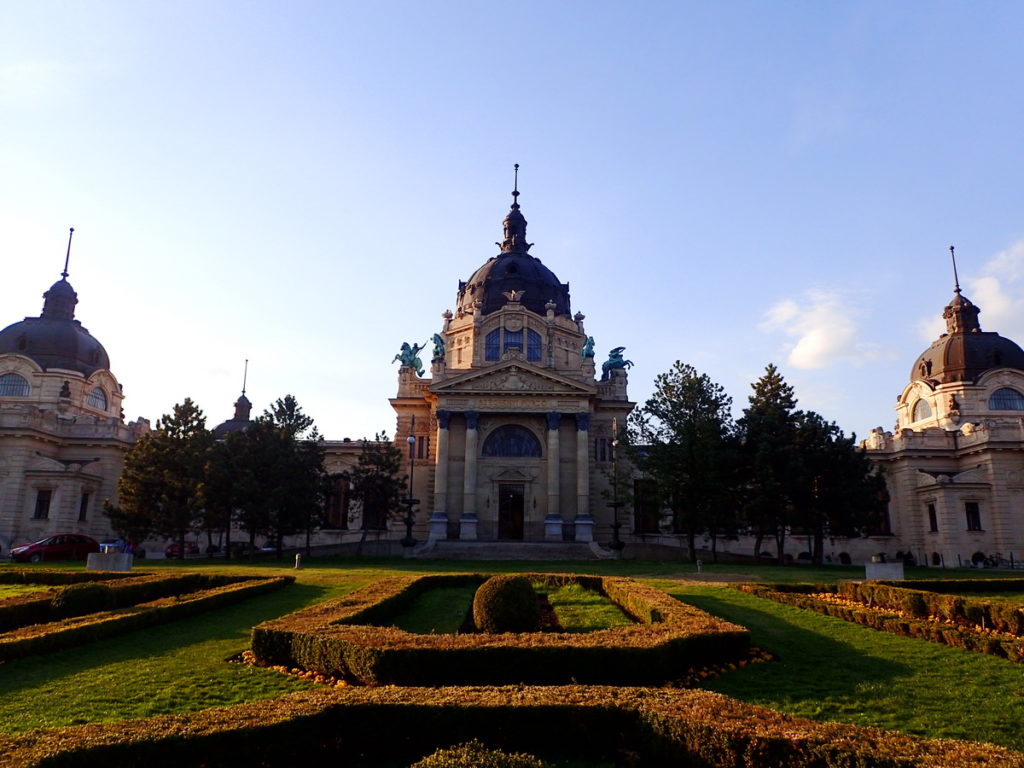
The Palatial Neo-Baroque Széchenyi Baths 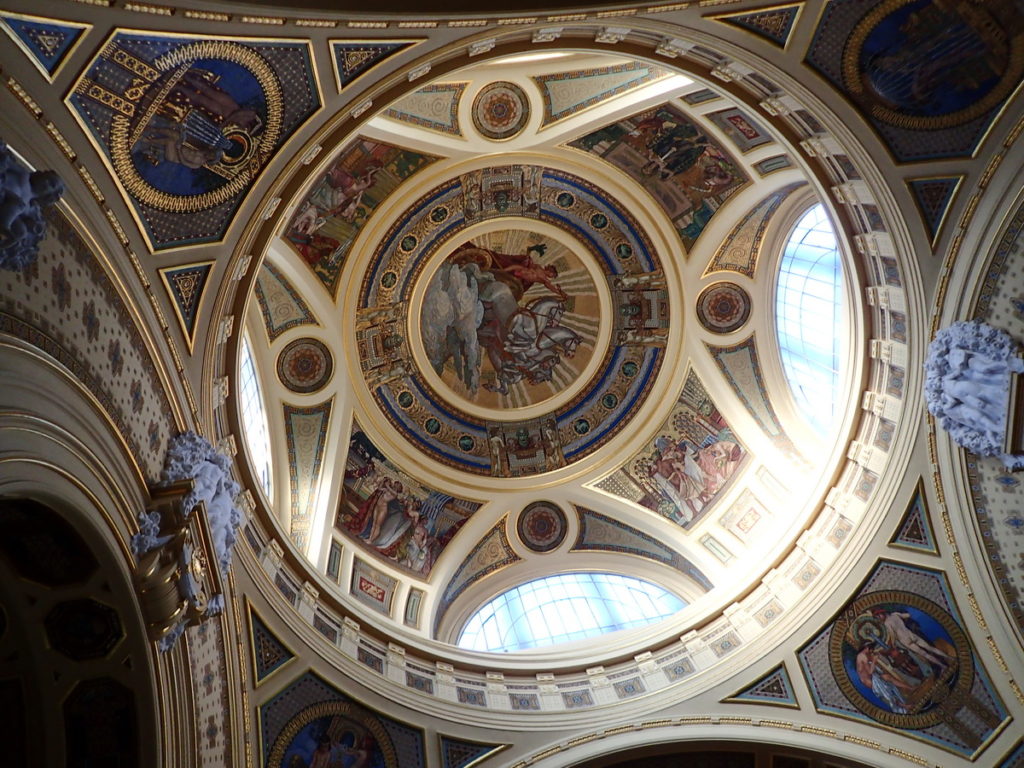
The dome of the foyer of the Széchenyi baths, decorated with mosaics
This early 20th century neo-baroque bathing complex is an exercise in excess. The grand foyer of the Széchenyi Baths with its domed ceiling and mosaics is as lovely as any of the world’s great public spaces. That this is a monumental temple to bathing makes it even more spectacular.
Gyógyfürdő means “Healing Bath.” The hot springs of Budapest (there are 123 springs under the city) are not just luxuriously warm, but full of therapeutic minerals. This is Europe’s largest Thermal Bath complex, and it consists of many, many pools of varying temperatures, both inside and out, as well as steam baths and saunas. You can book a massage for an extra fee.
The architectural splendor carries on outdoors, even in winter. Old men play chess here, right in the water. It gets very crowded, in the summer especially. For that reason, it may not be the most tranquil spa experience that Budapest has to offer, but we’ll visit more spas tomorrow. For now, enjoy the splash and opulence.
Elegant Budapest City Break – Late Lunch at Gundel
With a history dating back to 1866, this restaurant in the Városliget is a Budapest institution. Gundel became synonymous with fine Hungarian cuisine by running the restaurant in the Hungarian Pavilion at the 1939 New York World’s Fair. This is a pricy place, but the prix fixe lunches are a better deal.
Andrassy Avenue – (Andrássy út)
Andrassy Avenue is Budapest’s most famous and luxurious street. Part of a grand urban plan, construction on the great avenue, leading from Erzsébet Square to the Városliget began in 1876. Palatial Neo-Renaissance mansions, designed by the most prestigious architects of the under the leadership of led by Miklós Ybl (the architect of St. Stephen’s Basilica), lined the avenue. It’s so magnificent that Andrássy Avenue was declared a UNESCO World Heritage Site in 2002.
The section of the avenue from the City Park towards Erzsébet Ter is the broadest section – villas surrounded by great gardens in front. Many of the Embassies are located in this section. Further along are mansions with gardens in front, then a section with universities and grand residences. After the Octagon, there’s more activity – the theaters of the “Pest Broadway” at the intersection of Nagymező utca, followed by the stupendous neo-renaissance Hungarian State Opera House of 1884 – also designed by Miklós Ybl. There are tours of the Opera house, but the inexpensive seats to a performance don’t cost so very much more. (The Opera is currently closed for restoration and due to open sometime in 2021).
This area has the finest shopping and strolling in Budapest, luxury boutiques interspersed with fine cafés and restaurants. Andrassy Avenue is where contemporary elegance and Budapest’s fin de siècle glamour come together.
Wine Bars and Ruin Pubs in the Old Jewish Quarter – the Erzsébetváros (District VII)
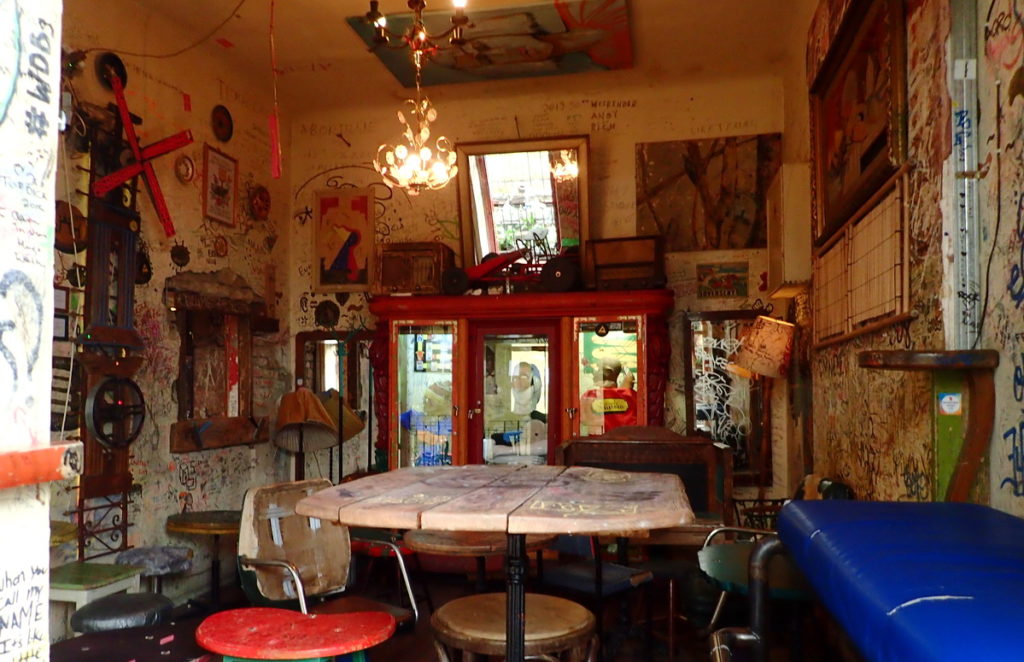
One of several rooms of Szimpla Kert 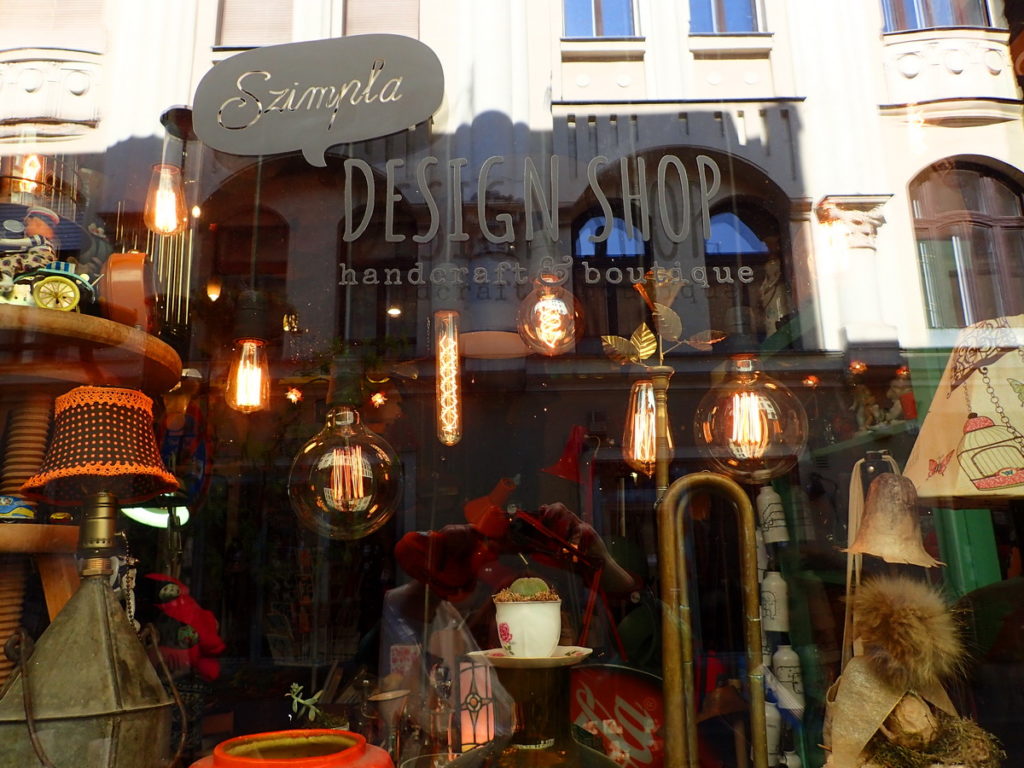
The Szimpla design shop
District VII is now one of the post popular destinations in Budapest, but don’t let that put you off. If there’s a line to get into Szimpla Kert – the pioneering Ruin Pub that defined the genre – then there are plenty of others to choose from. Grandio doubles as a hostel, and has a courtyard for enjoying a drink outdoors, or coffees in the afternoon. Mazel Tov morphs into more of a bar scene by night. At Instant, you have your choice of rooms – it’s an entire apartment building. Fogasház (“house of teeth” – there used to be a dentist here), is part of Instant. It also has a courtyard, is a little quieter and has a lot more art – they host exhibitions here.
Even if you’re not for bar hopping, it’s nice to at least glance at a couple of these because they are such a part of Budapest’s contemporary culture. The old Jewish quarter also has some charming wine bars where you can sample a great selection of Hungarian wines by the glass. An introduction to Hungarian wines is a fun part of a Budapest 2 day itinerary. Tokaji – the rich golden white of the Tokaj region – is the best known. From the same region there are also dry whites, called Furmint. Also try Egri Bikaver – the famed “bulls’ blood” of Eger – just as a beginning. Kardaka has over 100 varieties of Hungarian wines. The cozy and dark Dobló with its raw brick walls has a smaller selection (30+ wines, all Hungarian), but an inviting and intimate atmosphere.
If you get hungry, this is a great neighborhood for food. There are several good Kosher restaurants for some satisfying eastern European Jewish specialties – try Hanna, which is very close to Szimpla Kert. Gettó Gulyás offers sophisticated twists on Hungarian classics.
2 Days in Budapest – Buda (Mostly)
Hilly, peaceful Buda had a completely different mood. The topography is a little more wild, with the Gellert Hill and the Buda Hills providing drama and cutting down on traffic. The broad avenues near Gellert Hill are lined with beautiful fin de siecle apartment buildings and side streets are filled with trees and beautiful homes. Castle Hill is filled with romantic attractions, like Buda Castle, the Fishermen’s Bastion, and the Matthias Church. Meanwhile, centuries roll back in charming and sleepy Budapest old town, the tangle of little streets on Castle Hill behind the major monuments. Some of the best Budapest Baths are on this side – including the opulent Art Nouveau Gellért, and the Turkish Rudas and Király Baths. If spa time is a priority, we can even do both. After seeing the Parliament building framed by the Fishermen’s Bastion, we can walk across the famous Chain Bridge to see it up close – stopping to admire the historic Four Seasons Hotel in its Art Nouveau splendor.
A 2 Day Budapest Itinerary, Day 2, Morning – Gellert Hill, Gellert Baths, and Gellert Cafe. Then the Buda Castle, Fisherman’s Bastion, and Matthias Church, plus a slice of Esterházy torta at Ruszwurm
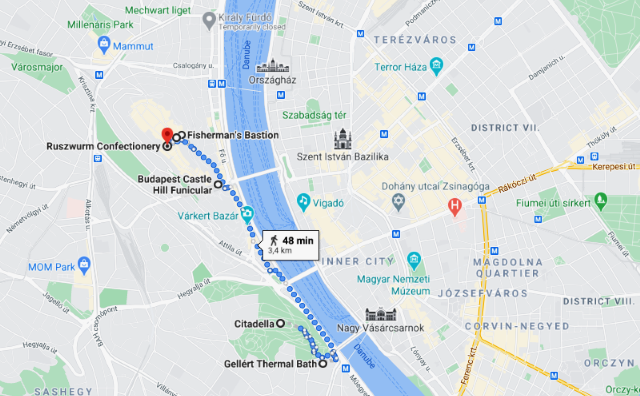
It will be a morning of hills – first the Gellert Hill, then Castle Hill – and a morning of views. We’ll also fit in a visit to the most photographed of all of Budapest’s thermal baths, see three of the most famous sights of Budapest, and have coffee and cake – twice, actually.
Gellért Hill
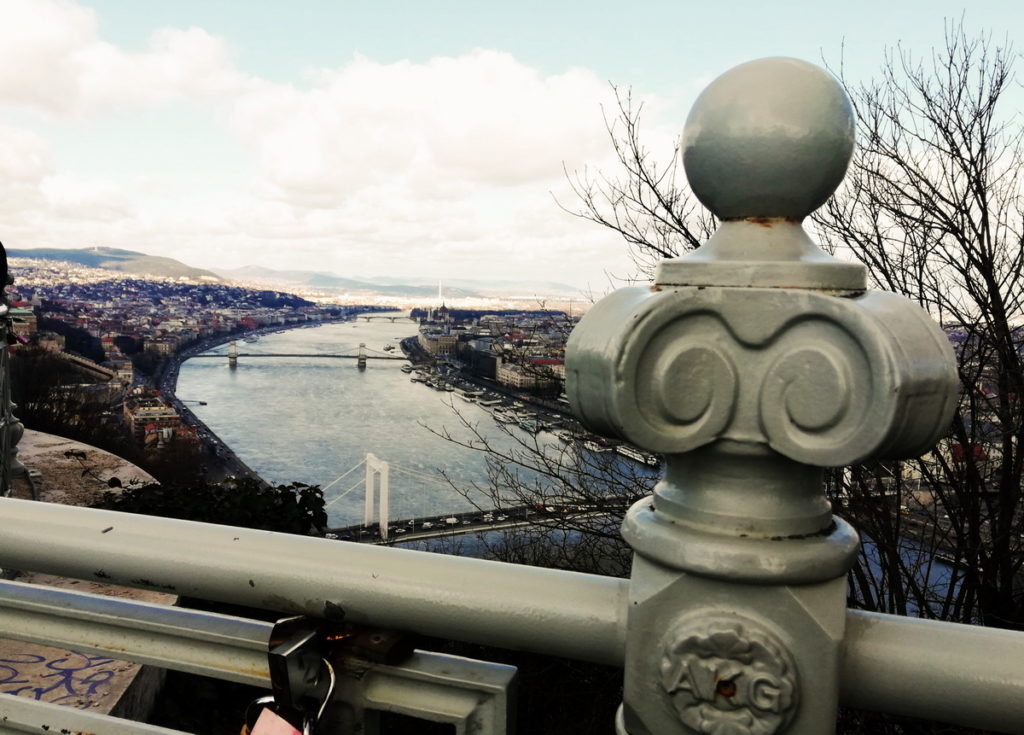
This is a great place to start the day. And it pays to start as early as possible if we want to fit in two spa sessions. The lovely wooded Gellért Hill rises 235 meters (770 feet) and makes fine short walk. Paths ascend right across the street from the Gellert Baths, passing the Gellért Hill Cave (Gellérthegyi-barlang) which is directly across from the Gellert Hotel. It’s also called “Saint Ivan’s Cave” (Szent Iván-barlang) for the hermit who once lived here an healed the sick with thermal waters. At the summit of the hill are splendid views of the Danube, the Liberty Bridge, and Pest. There is also the Citadella – built after the 1848-1849 Hungarian uprising against the Hapsburgs. The glorious Liberty statue is from the Soviet era, erected by the Red Army to commemorate victory over the Germans. The Gellért Hotel right beside the hill sustained heavy damages, and continued to operate while partly in ruins for many years after the war.
The Gellért Hill (Gellérthegyi) is named for Szent Gellért – Saint Gerard, who was martyred here during a great Pagan rebellion in 1046. After his death, the hill was unpopulated and grew ever more densely wooded, giving rise to ideas that witches met here. Much later, in the 18th century, the Gellért Hill was covered in vines, supplying the wine production in Tabán – the 1st district – at the northern base of the hill.
The Gellért Baths – Gellért gyógyfürdő
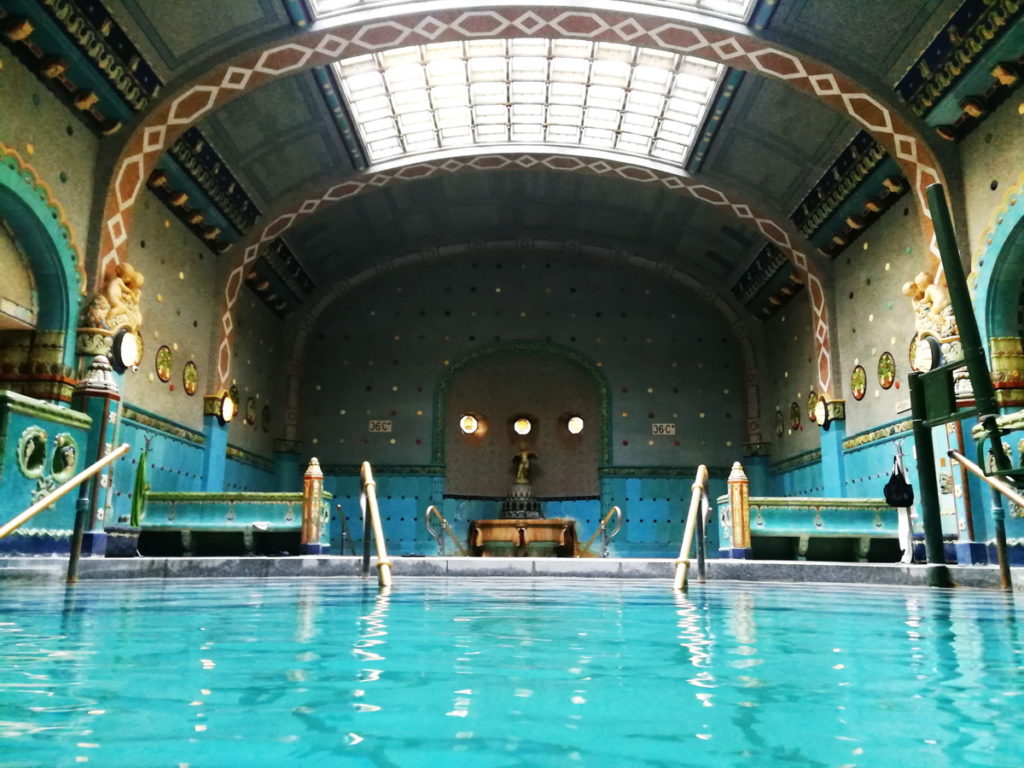
Inside the Thermal Pools of the Art Nouveau Gellért Baths 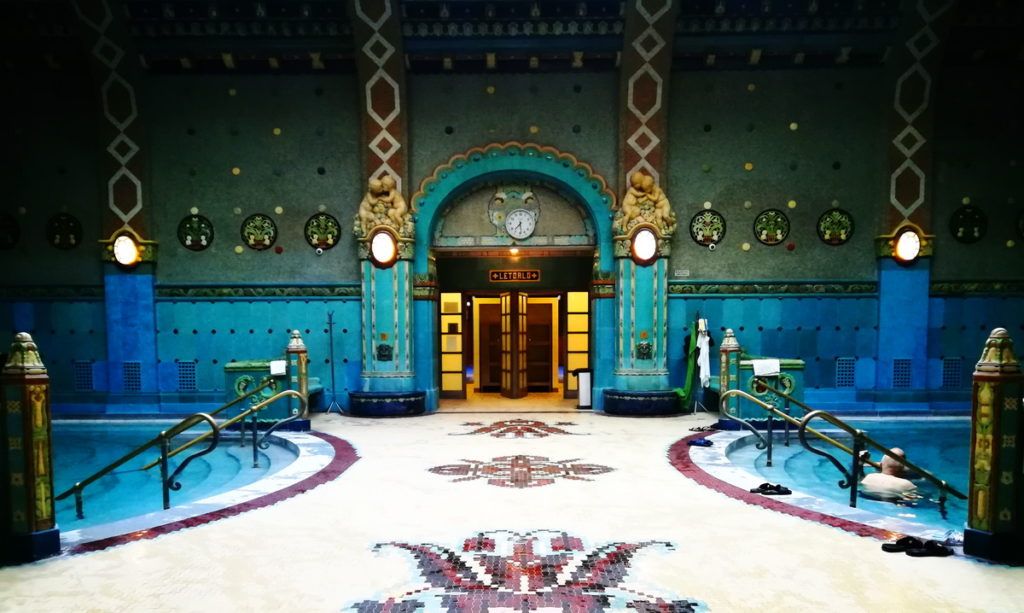
The ornate Zsolnay tiles were custom-cast for the baths
These Art Nouveau baths of 1918 were designed – along with the Gellért Hotel, part of the same building – by Ármin Hegedűs (architect, along with Henrik Böhm of the Török Bank- one of Budapest’s landmark Secession-style buildings), Artúr Sebestyén and Izidor Sterk. The domed entrance hall is every bit as grand as that of the Széchenyi Baths, and that’s just the beginning. These are Budapest’s most opulent baths. Decked out completely in ornate, custom cast, richly-colored Zsolnay tiles, the large, glass-ceilinged baths are among the most iconic images of Budapest. You’ll think you are bathing in a jewelry box.
There are two bath complexes, originally one for men and one for women. But today they are mixed. They’re identical in layout – each with large pools of 36 degrees and 40 degrees, a plunge pool, saunas, and steam baths. The women’s bath was damaged by bombing in WWII and although restored, is not quite as glamorous as what used to be the men’s bath. The men’s bath is the one furthest from the street entrance. Between the baths is an incredible swimming pool, also filled with therapeutic thermal waters (28 degrees), surrounded by tall, ornate columns, under a soaring glass roof. The snack bar by the pool dates from a later era, a beautiful example of communist era post-war design.
Entrance to the Baths is about 20 euros, making this one of the more expensive Thermal Baths of Budapest. It’s absolutely worth it.
Tip: For the best aesthetic experience, go as early as possible to appreciate the architectural spaces before the fill up.
Serious Pro-Tip: If the baths are the chief attraction on your Budapest city break, consider staying at the Gellert Hotel. Then you can just walk to the baths in your terrycloth hotel robe through the grand corridors. And you can get there when the baths open, at 6:00 am, while other tourists have just gone to bed after a night out in district VII.
A Melange at Gellért Eszpresszó
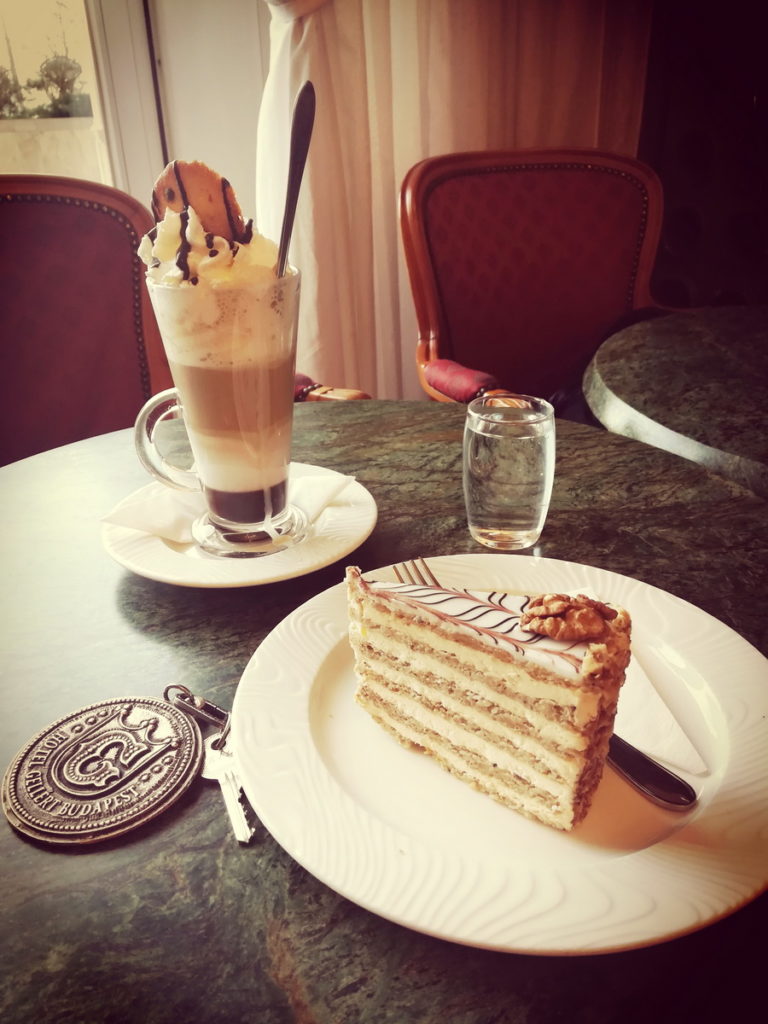
The coffee shop in the Gellért Hotel – the Gellért Eszpresszó – is a stylish bite of elegant 60’s pop, complete with inlaid marble and a honeycomb motif. Excellent coffee drinks and classic Hungarian pastries at a fine price, and very pretty terrace seating in good weather.
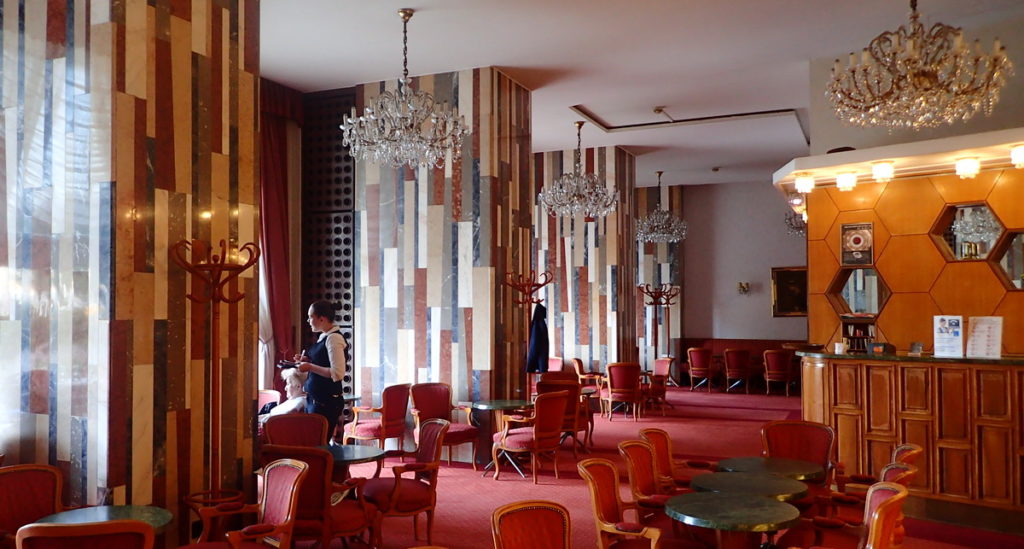
Budapest 2 Day Itinerary – Castle Hill, Buda
We can walk along the Danube for a little over half an hour, or take one of the trams that stop directly in front of the Gellert – the tram #19 and tram #41 both run along the Buda side of the Danube, and can bring us to the Budapest Castle Hill Funicular at Clark Ádám tér. From here, we can continue to walk – a path leads up the hill.
Buda Castle (Budavári Palota) – home of the Hungarian Kings, was initially built in the 13th century. Most of the castle we see today is Baroque, from the 18th century. Additions and restorations ensued over the years, including the neo-Renaissance arcades, pavilions, and staircases leading up to the castle complex from the banks of the Danube.
The Fisherman’s Bastion – Halászbástya
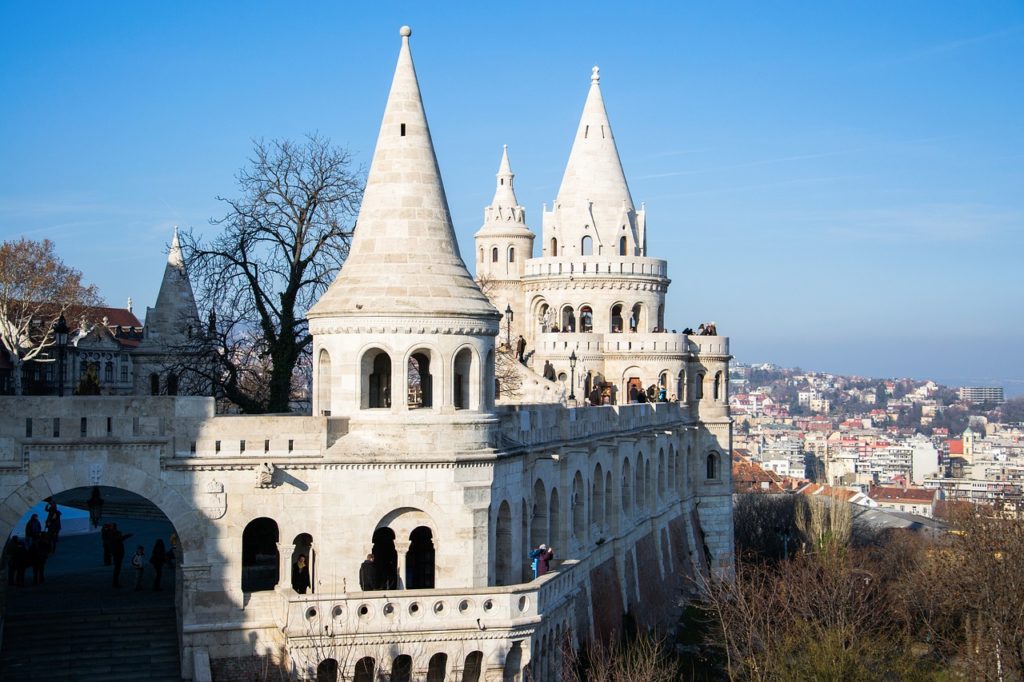
This neo-Romanesque fairy-tale of a fortress looks like it has always been here. But in fact this definitive Budapest monument dates – like many of the impressive sights of the city – to the late 19th century and the dawn of the 20th. Like Heroes’ Square, the Fisherman’s Bastion also pays tribute to the seven Magyar chieftains who founded Hungary, represented here by the Bastion’s seven towers.
There are two origins of the name Fisherman’s Bastion. This section of the old Buda walls was protected by the fisherman’s guild, string defenders of the city. Also, this area was once the Halászváros – “fish town” – the fishermen used to set up their wares in front of the Matthias Church, which is directly behind the Fisherman’s Bastion.
One of the reasons that the Fisherman’s Bastion today is for the outstanding views – seeing the Parliament building framed by the neo-Romanesque arches of the Fisherman’s Bastion is one of the classic images of Budapest. The splendid 140 meter long bastion was designed by Frigyes Schulek and constructed – like Heroes’ Square (Hősök tere) – to commemorate the millennial anniversary of Hungary. Schulek was also responsible for the spectacular rebuilding of the Matthias church.
Matthias Church – Mátyás-templom
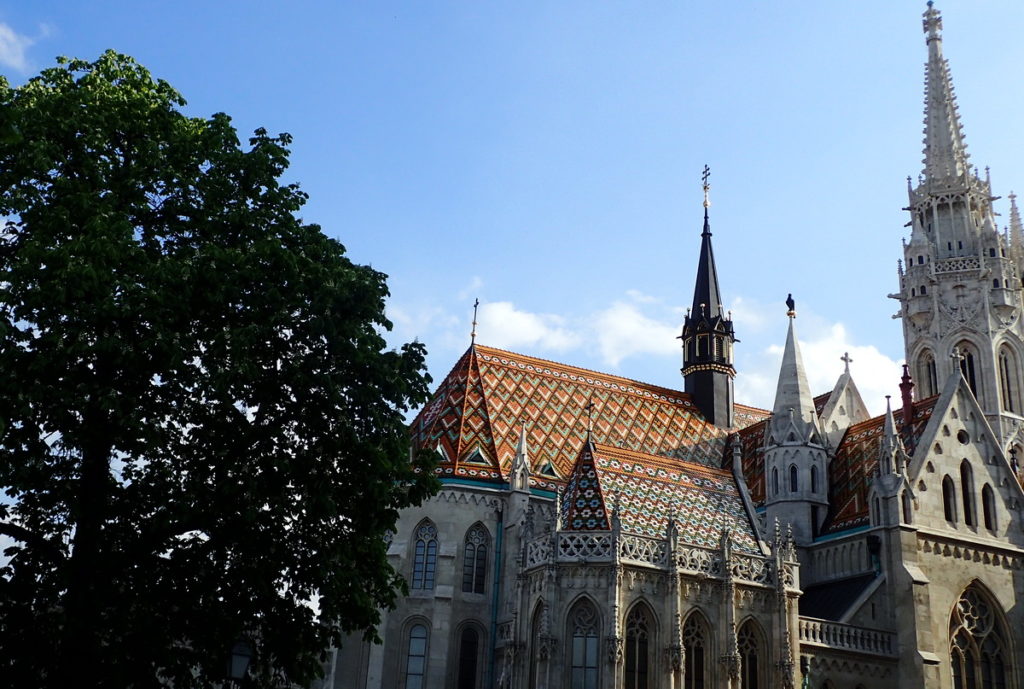
The bold diamond-patterned roof tiles added in the restoration of the Matthias Church 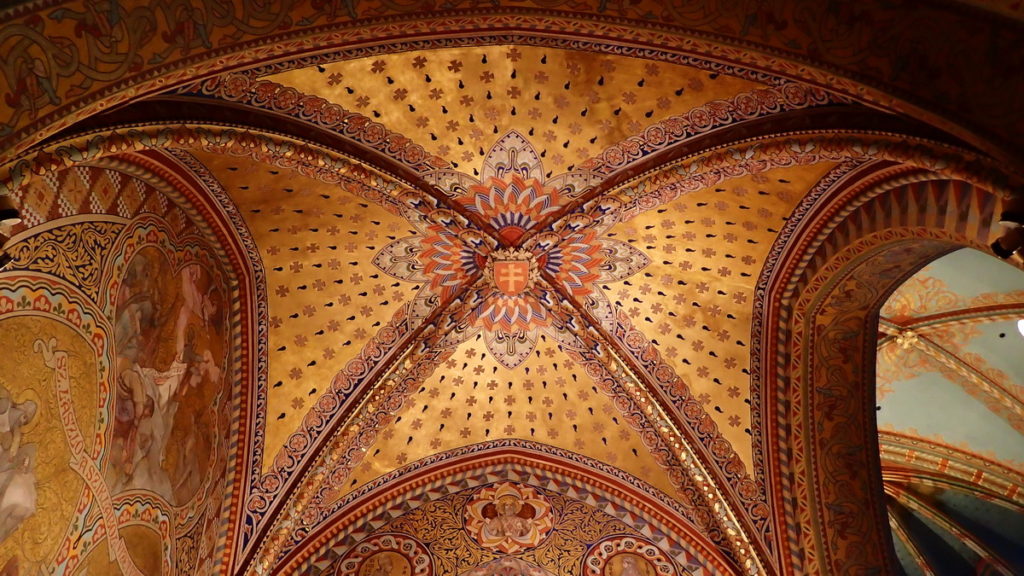
Details of the Hungarian Art Nouveau interior of the Matthias Church
The Matthias Church – the Church of the Assumption of Buda (Nagyboldogasszony-templom) – is one of the key landmarks of Castle Hill, and an essential place to visit for fans of architecture and design. The 14th century (late gothic) church was restored at the time of the building of the Fisherman’s Bastion. Famous painters of the day – Bertalan Székely and Károly Lotz – saw to the interior decoration, guided by the remnants of medieval wall paintings. The interior – whose every surface is elaborately painted – is spectacular, and seems to reflect a distinctively Hungarian identity. The bold design reflects the Secession style of the era, uniting geometric and botanical motifs and a vibrant palette to splendid effect. The interior of the Matthias Church is one of the masterpieces of Eastern European Art Nouveau.
Matthias, the 15th century King for whom the church is now named, is the favorite of the Kings for many Hungarians. Many folk tales are written about him. Both of his marriages took place in the Church of the Assumption, which then later acquired his name.
The colorful roof tiles and their diamond motif are one of the most distinctive and delightful features of the church. At the time, they were one of the most controversial elements of Frigyes Schulek’s bold and masterful restoration.
Ruszwurm Cukrászda, the Oldest Pastry Shop in Budapest
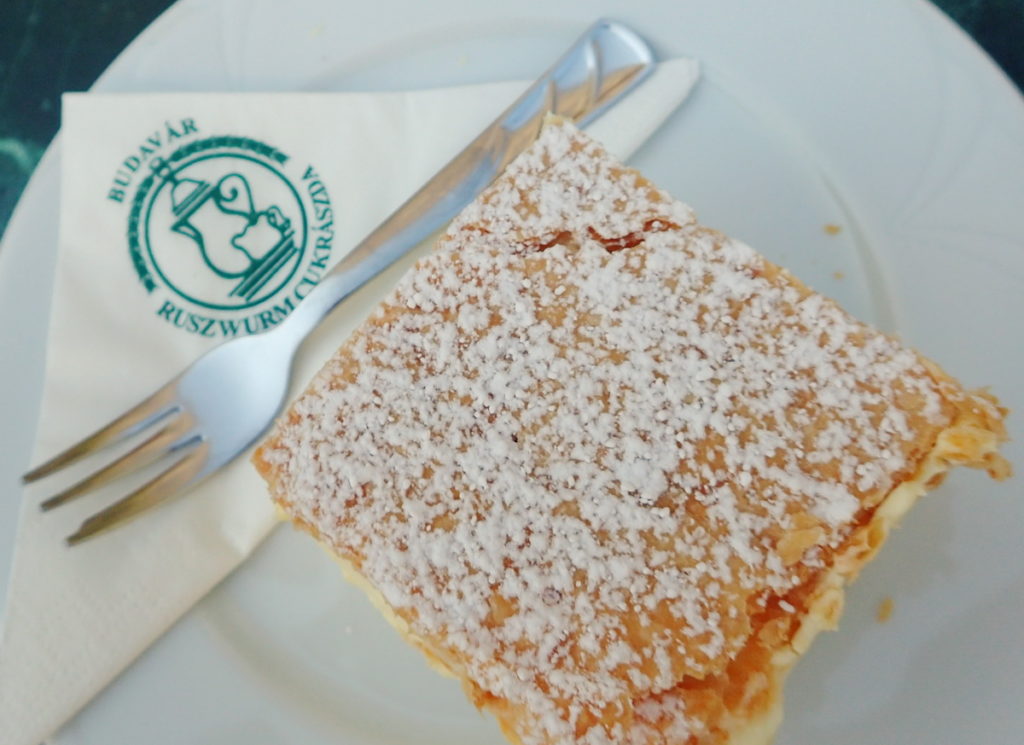
Excellent Krémes at Ruszwurm 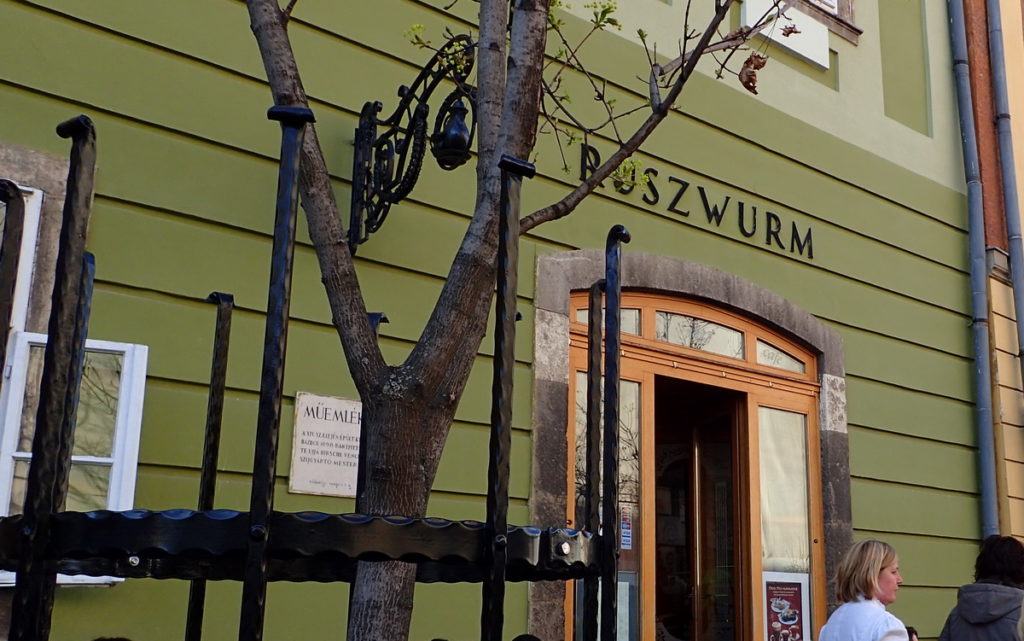
Budapest’s Oldest Pâtisserie, Ruszwurm, in the Castle District
Ruszwurm Cukrászda (Confectionery) has been making the finest classic Hungarian pastries and tortes since 1827. Come for a coffee and for a selection of classic specialties like krémes, Esterházy torte, Dobos torte, and Sacher torte. Esterházy torte is a multi-layered walnut or almond sponge, layered with buttercream, scented with rum, and glazed with marbled fondant. krémes is simplicity itself – a deceptively plain-looking square of crème pâtissière sandwiched between crisp and light squares of puff pastry. Freshness and quality are paramount, and Ruszwurm is therefore the ideal place to try it.
Ruszwurm is just steps from the Matthias Church. The surrounding cobblestone streets of old Buda, lined with two-story buildings with pastel facades, have a charming distinctive character.
2 Days in Budapest Itinerary, Day 2, Afternoon
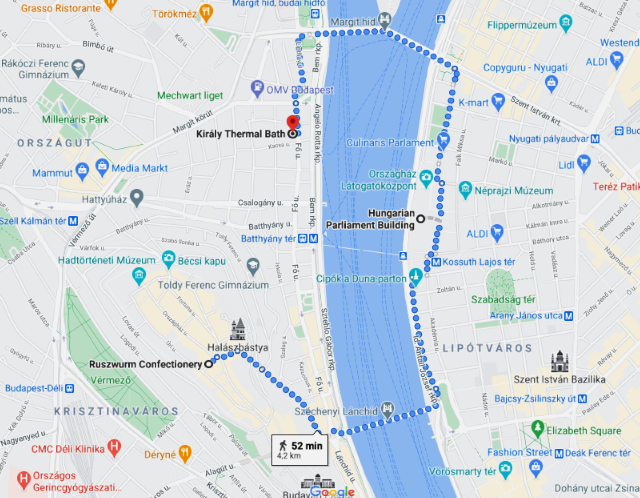
For the afternoon, we’ll pop back across the river to Pest to visit the Parliament Building, then back again further north for a completely different Budapest Bath experience at the Turkish-style historic Kiraly Baths
The Hungarian Parliament Building – Országház
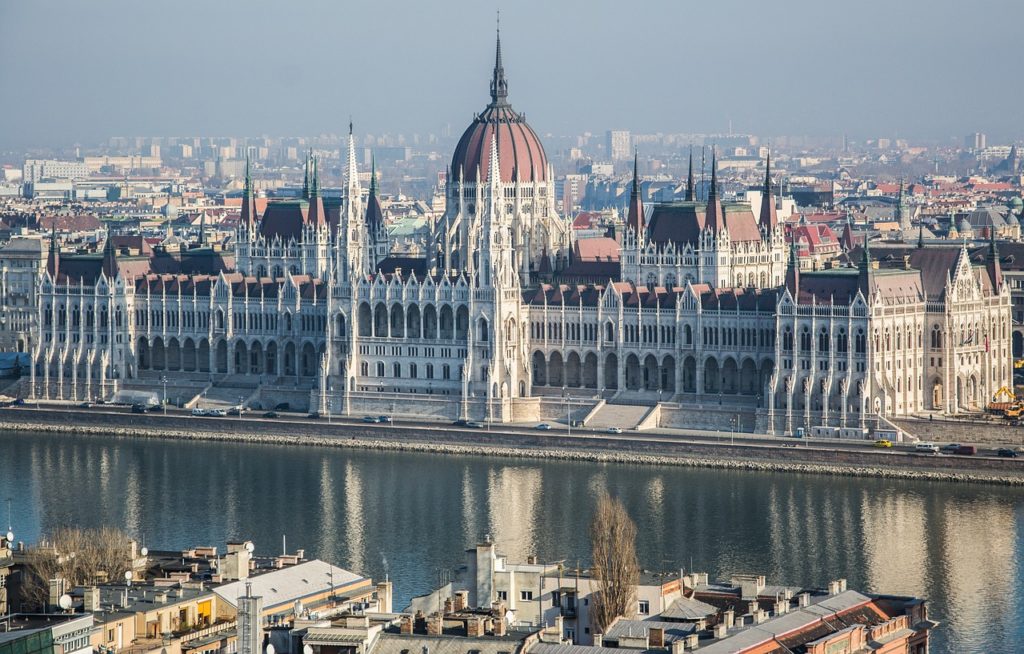
The Splendid neo-Gothic Hungarian Parliament Building 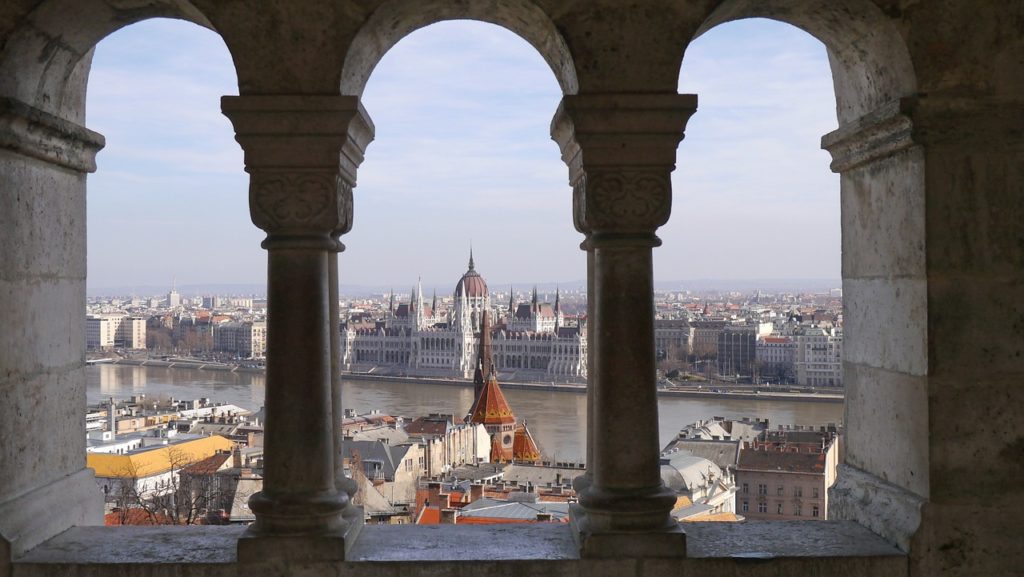
The View of the Parliament Building from the Fisherman’s Bastion
The Hungarian Parliament Building (Országház – “House of the Nation“) is one of the most famous monuments of Budapest. A splendid Gothic-revival wonder, the Hungarian Parliament Building is much larger than a country of this size might ordinarily need. 268 meters long, it is only slightly smaller than the British Houses of Parliament (298 meters). Why so large? The Hungarian Parliament Building has a fascinating historical background. Its grandeur and size symbolize the hard-won autonomy of the Hungarians. For centuries, they were ruled for years by the Ottomans (1451 – 1699). Then they were under the rule of Austria. There was an unsuccessful uprising (1848 -1849). Finally, with the Austro-Hungarian compromise of 1867 – resulting in a dual Monarchy in which the King and Queen of Hungary were also the Emperor and Empress of Austria (with Franz Joseph and Elizabeth -“Sisi” the first dual monarchs) – Hungary had more power. The Parliament Building reflects, and even celebrates, the new status of Hungary within the powerful Austo-Hungarian Empire.
The construction of the Hungarian Parliament Building was begun in 1896 on the supposed millennial anniversary of Hungary, and was competed in 1904. Its height – 96 meters – is symbolic for two reasons. The number 96 refers to the the nations millennium, commemorating the anniversary of the founding of Hungary (896). Also, its height is equal to that of St. Stephen’s Basicila, symbolizing a harmony and balance between Church and State.
Reflected in the waters of the Danube, the intricate Gothic façade is magnificent. The inside is just as spectacular. Features include the 16-sided central hall, matching assembly halls, grand staircases, and courtyards (10). Decoration includes over 240 sculptures, on the inside and outside of the building, as well as ceiling frescoes. Particularly distinctive features are the stained glass and glass mosaics of glass work by Miksa Róth. He was inspired by the pre-Rafaelites and the artists of the Arts and Crafts movement, and can be credited with making stained glass and mosaic prominent Hungarian art forms.
The Király Baths (Király fürdő)
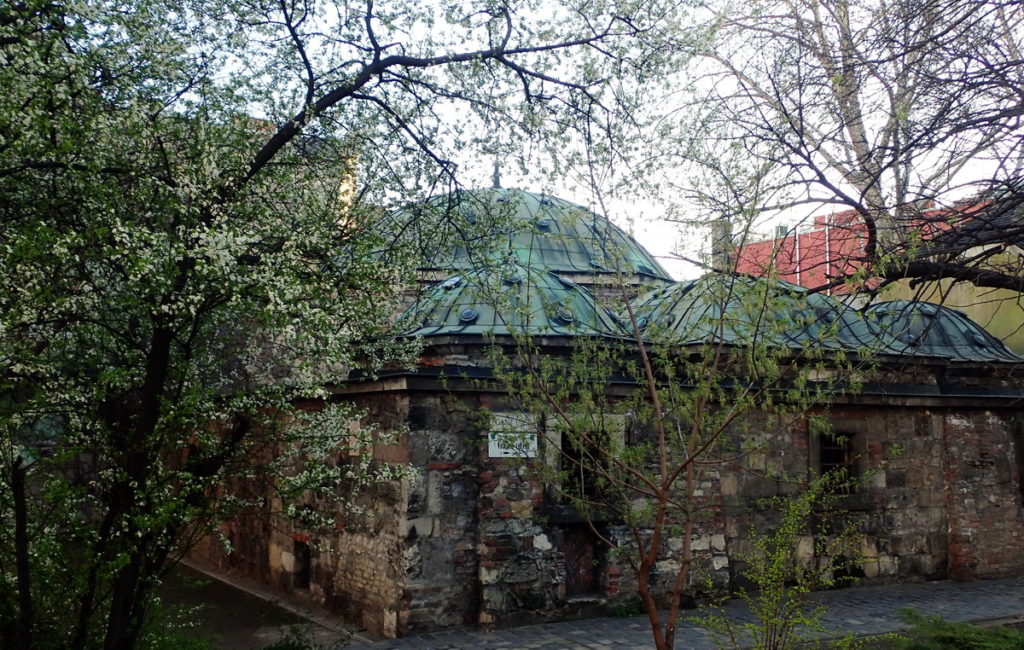
Shortly after the Ottomans invaded Hungary in 1541, during the reign of Suleiman the Magnificent, they started building grand Turkish-style hamams to take advantage of the abundant natural hot springs of Budapest. The Király fürdő – “Royal Baths” is one of them.
This thermal bath has a more local crowd, and an authentic atmosphere. The great pool under the high dome feels like it has not changed over the centuries. Organic additions – like the saunas with their 1960s-style tiled ceilings – add their own layers of character.
The Király fürdő is slightly less expensive than the Széchenyi and the Gellért, which also goes for the expert, physical-therapy-style massages

